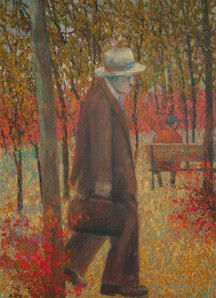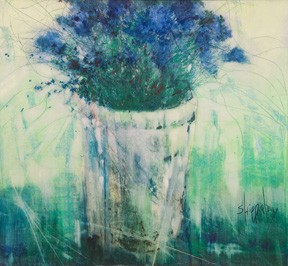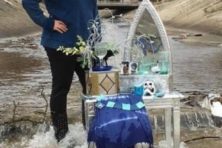Q&A with Artist George Shipperley
- Share
- Tweet
- Pin
- Share
My gaze always lingers over George Shipperley’s distinct and brilliant oil pastel paintings. The highly acclaimed impressionist painter who shows at Edgewood Orchards Galleries in Fish Creek presents primarily colorful floral still lifes and landscapes that captivate the viewer, calling for a second look or two or three.
Shipperley’s work is currently featured in Edgewood’s Exhibit I and he will soon teach a class at Peninsula School of Art in Fish Creek.
I spoke with the artist about his work, his influence, and what he stresses most when he teaches his craft.
Sally Slattery (SS): Do you recall when you began to create art?
George Shipperley (GS): My interest in art began in my junior year of high school in Aurora, Illinois, in 1954. As a class, we experimented with many mediums but I immediately took to painting. Plus it was an easy ‘A’ and I wasn’t getting too many of those at the time.
After graduation, I was very fortunate in finding an insightful art instructor and gifted artist, Marianne Grunwald-Scoggin, who was most influential in guiding me through the learning process, both technically and creatively. Whatever artistic skills I have today came through her guidance and insistence for originality. For this I am very grateful, for it steered me in the right direction early on in my career.
SS: You retired from a sales career in 1994, how did your art career begin?
GS: After 33 years in sales, in 1994, I took an early retirement from the Michelin Tire Co. to become a professional artist, which I could not have done without the love and support of my wife, Lois. It was a gamble, but I knew if we delayed it any longer I would have regretted not taking that gamble.
It took awhile to establish myself, but the big break came when I applied to Edgewood Orchard Galleries and was accepted into their family of artists, that was the real turning point in my career. I got lucky!

“Walk in the Park” by George Shipperley.
SS: You often paint colorful representations of flowers, are these created from your imagination?
GS: Most of my work comes from within. I have always relied on my imagination with rare exceptions such as specific cityscapes or landmarks. Still lifes, such as florals are always imaginary, for I am more interested in the interpretation. To me it’s never the subject but how one paints it that really matters. This is what makes us artists, having the ability to give the viewer something they have never seen before.
SS: How would you describe your work?
GS: Describing my work has always been a bit difficult because I am forever experimenting, not so much with mediums but with technique and style. Two common denominators, I suppose, would be impressionistic and expressionistic. Still lifes tend to be more colorful and landscapes more traditional. Again, it’s simply the end result that really matters and whatever style or method I choose to achieve this result is always optional. That’s the luxury of an imaginary artist.
SS: How long, from start to finish, does it usually take you to complete a painting?
GS: Regarding the amount of time it takes to complete a painting is also difficult to answer, because it depends on the size and subject matter. Some works are completed in one or two days, others take a week or more, such as a large cityscape or café scene. I don’t do preliminary sketches so all my compositional changes are made during the painting process itself. This process takes longer but I get a more spontaneous effect.
SS: How has your work changed over the years?
GS: My work has changed over the years in various ways, such as refinement of technical skills, more ambitious undertakings, more contemporary, especially still life pieces and finally, less regard for subject matter and more attention to projecting a feeling or mood or as I often say, a mystique. Less is more!
I would add, that if our work doesn’t change or evolve over the years, we become stagnant, bored and lose the vitality of our work. True artists have an insatiable appetite to create and sustain this by forever evolving and changing.

“A Beautiful Day” by George Shipperley.
SS: What artists have influenced your work?
GS: Many artists have influenced my work, both famous and not famous. Most influential are Camille Corot, George Inness, Augusta Renoir and, of course, Claude Monet – Corot and Inness for tonality and Renoir and Monet for mastery of color. Our emulation of great artists motivates us to better our own style and technique, not to imitate but build on what they discovered and perfected. Most of us, myself included, may never achieve our goals and ambitions, but most certainly will persevere.
SS: You are also an instructor at various art schools, including Peninsula School of Art. What do you stress to your students when it comes to creating art?
GS: Teaching has been a rewarding experience by allowing me to pass on what I have been fortunate to learn over the years. Not only do I teach, but learn from others as well. Teaching is a serious responsibility, not to promote ourselves but to recognize the talents of others and guide them in the direction most suitable to their needs and desires. That’s what they pay us for.
Most of my classes comprise of artists of all levels, beginner, intermediate and advanced, so although it is a class, my efforts are tailored to each individual. There are however, a number of principles pertinent to all, regardless of one’s experience that I will always emphasize in class. First and foremost is originality, that means creating one’s own composition, design and color palette; interpretation, not rendering of subject matter; and willingness to experiment by trusting in oneself; and finally, perfecting one’s drawing skills. The better your drawing, the better your painting.
SS: You display at Edgewood Orchard? How did the Door County connection come about?
GS: I have always felt that luck plays an important part in one’s career, and my luck surfaced when I applied to Edgewood Orchard Galleries in 2006, and was accepted for the 2007 seasonal opening.
Not only am I grateful to Edgewood Orchard Galleries for giving me this opportunity but also to several friends who visit Edgewood annually and insisted that I apply. It wasn’t until one of them actually picked up an application form and personally delivered to me that I responded. I can actually say, Edgewood put me on the map, not just in the Door County and Wisconsin area, but also throughout the United States.
SS: What is the most rewarding aspect of creating art?
GS: Being an artist has many rewards but the greatest is the continued satisfaction one receives upon completing each new work of art, and discovering the improvement we make from one year to the next.
I have often said, I will never be as good as I aspire to, but will get better and better if I continue to paint and challenge myself daily. It is this passion that motivates me, and for that I am most grateful. How much better can it be than to earn one’s living by doing what you really love to do with the total support of your wife and family? So many are not as fortunate as I.
Edgewood Orchard Galleries, located at 4140 Peninsula Players Road between Fish Creek and Egg Harbor, is open daily from 10 am – 5 pm. For more information call 920.868.3579 or visit http://www.edgewoodorchard.com. Shipperley is one of the featured artists of the gallery’s Exhibit I, currently on display until June 12.
Shipperley will teach “Unique Interpretations in Oil Pastel” at the Peninsula School of Art in Fish Creek, June 20 – 22 for all levels. For more information visit http://www.peninsulaschoolofart.com or call 920.868.3455.
To view more of Shipperley’s work, visit http://www.georgeshipperley.com.




